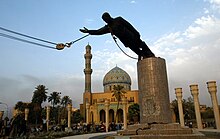Firdaus Square
The Firdaus Square or Firdos Square or English Firdos Square ( in Arabic ساحة الفردوس, DMG Sāḥat al-Firdaus 'Paradise Square', from Persian-Arabic firdaus , 'garden', 'delightful garden', 'paradise', from Old Persian pairidaẹza , 'fence', 'garden') is a public square in Baghdad , Iraq who became known to a larger international audience on April 9, 2003 when the tallest Saddam statue was overthrown.
On the square is Baghdad's tallest building, the so-called Ishtar Sheraton Hotel (second tallest structure after the Baghdad TV tower , which despite the name does not belong to the Sheraton chain) and the 14-story Palestine Hotel .
Today the square is often used for demonstrations, but is not directly in the government district.
Statues
In 2002 a huge Saddam statue was erected on the dictator's 65th birthday. In 2003 it was effectively torn down by the 3rd Battalion 4th Marines after critics such as the left-wing English journalist Robert Fisk . The New Yorker sums up the doubts:
- “The 2004 documentary film“ Control Room ”featured Al Jazeera journalists who argued that the toppling of Saddam's statue was merely“ a show. . . a very clever idea, ”and that Iraqis had been brought to the square like actors delivered to the stage. Skeptics have also questioned whether the crowd was as large or as representative of popular sentiment as US officials suggested. Might it have been just a small group of Iraqis whose numbers and enthusiasm were exaggerated by the cameras? “ , But she thinks it is wrong.
Rather, the commander, Lieutenant Colonel Bryan McCoy, spontaneously decided, on the initiative of the assembled Iraqis, to comply with the wishes of the locals and at the same time to offer something to the many journalists in the hotels on the square.
Today there is an abstract sculpture by the artist Bassem Hamad al-Dawiri on the base, which is supposed to symbolize freedom.
Individual evidence
- ^ Karl Lokotsch : Etymological dictionary of the European (Germanic, Romanic and Slavic) words of oriental origin . Carl Winter, Heidelberg 1927; 2nd, unchanged edition 1975 (= Indo-European Library , 2), ISBN 353302427X , p. 131 (see Hebrew pardēs ).
- ^ NY Times
Web links
Coordinates: 33 ° 18 ′ 52.7 ″ N , 44 ° 25 ′ 14.9 ″ E
